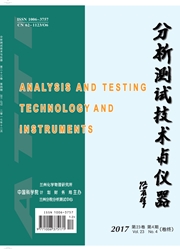

 中文摘要:
中文摘要:
制备了新型的介孔碳纳米纤维修饰热解石墨电极(MCNF/PGE),并将其用于芦丁含量的测定。用循环伏安法、交流阻抗谱法、示差脉冲伏安法研究了该修饰电极膜性能及芦丁在该修饰电极上的电化学行为。结果表明,修饰电极可有效促进探针离子[Fe(CN)6]3-/4-在电极表面的电子传递;芦丁在该修饰电极表面的电化学过程受扩散控制。由于MCNFs大量的石墨边缘缺陷、大比表面积以及介孔结构,与裸电极相比,该修饰电极对芦丁呈现出很高的电催化活性,芦丁阳极峰电流约为裸电极上的18倍。在最佳实验条件下,芦丁的氧化峰电流(Ipa)与其浓度(c)在2.0×10-8~1.2×10-6mol/L范围内呈良好的线性关系,检出限(S/N=3)为5.0×10-9mol/L,线性系数r2=0.999。此外,计算了电荷转移系数(α)、标准速率常数(ks),并推测了芦丁的电化学氧化还原机理。该修饰电极易于制备、可再生,重复性及稳定性良好,可作为一种高灵敏度的电化学传感器应用于芦丁片剂中芦丁的含量测定。
 英文摘要:
英文摘要:
A new mesoporous carbon nanofibers modified pyrolytic graphite electrode(MCNF/PGE) was prepared and applied in the electrochemical determination of rutin.The characteristics of MCNF/PGE and the electrochemical behavior of rutin on the modified electorde were investiged by different methods including cyclic voltammetry,electrochemical impedance spectroscopy and differential pulse voltammetry.The results showed that MCNF/PGE had a good electrocatalytic response to the electron transfer of [Fe(CN)6]3-/4-.The system presents features corresponding to a diffusion-controlled process of rutin on the surface of MCNF/PGE.Compared to the bare PGE,the proposed modified electrode possesses a high electrocatalytic activity towards the redox of rutin because of the large-amount of edge plane-like defects,the large surface area and the mesoporous structure of MCNFs.The anodic peak current(Ipa) of rutin at the MCNF/PGE is 18-fold higher than that of the bare PGE.Under the optimal conditions,the anodic currents of rutin are linear with its concentrations(C) in the range of 2.0×10-8-1.2×10-6 mol/L with a detection limit(S/N=3) of 5.0×10-9 mol/L.The linear equation is Ipa(μA)=-0.415 + 39.104 c(μmol/L),with a correlation coefficient of 0.999.In addition,the electron transfer coefficient(α),standard rate constant(ks) and the redox mechanism of rutin at the modified electrode were calculated.The MCNF/PGE exhibited distinct advantages of simple preparation,surface renewal,good reproducibility and good stability,and can be used as a good electrochemical sensor for the determination of rutin in real tablet analysis.
 同期刊论文项目
同期刊论文项目
 同项目期刊论文
同项目期刊论文
 Novel indole based colorimetric and "turn on" fluorescent sensors for biologically important fluorid
Novel indole based colorimetric and "turn on" fluorescent sensors for biologically important fluorid 期刊信息
期刊信息
